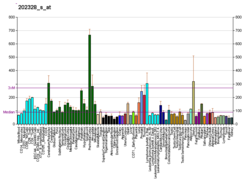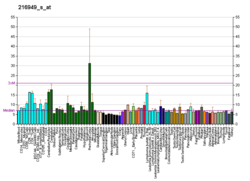User:ADTelo/sandbox/Polycystin 1
Polycystin 1 (often abbreviated to PC1) is a protein that in humans is encoded by the PKD1 gene [5][6]. Mutations of PKD1 are associated with most cases of autosomal dominant polycystic kidney disease, a severe hereditary disorder of the kidneys characterised by the development of renal cysts and severe kidney dysfunction [7].
Protein Structure and Function
[edit]
PC1 is a membrane-bound protein 4303 amino acids in length expressed largely upon the primary cilium, as well as apical membranes, adherens junctions, and desmosomes [8]. It possesses eleven transmembrane domains, a large extracellular N-terminal domain, and a short (~200 amino acid) cytoplasmic C-terminal domain [8][9]. This intracellular domain contains a coiled-coil domain through which PC1 interacts with polycystin 2 (PC2), a membrane-bound Ca2+-permeable ion channel.
PC1 has been proposed to act as a G protein–coupled receptor [8][10]. The C-terminal domain may be cleaved in a number of different ways. In one instance, a ~35 kDa portion of the tail has been found to accumulate in the cell nucleus in response to decreased fluid flow in the mouse kidney [11]. In another instance, a 15 kDa fragment may be yielded, interacting with transcriptional activator and co-activator STAT6 and p100, or components of the canonical Wnt signaling pathway in an inhibitory manner [12][13].
Evidence suggests that PC1 mediates mechanosensation of fluid flow by the primary cilium in the renal epithelium and of mechanical deformation of articular cartilage [14].
Gene
[edit]Splice variants encoding different isoforms have been noted for PKD1. The gene is closely linked to six pseudogenes in a known duplicated region on chromosome 16p.[15]
References
[edit]- ^ a b c GRCh38: Ensembl release 89: ENSG00000008710 – Ensembl, May 2017
- ^ a b c GRCm38: Ensembl release 89: ENSMUSG00000032855 – Ensembl, May 2017
- ^ "Human PubMed Reference:". National Center for Biotechnology Information, U.S. National Library of Medicine.
- ^ "Mouse PubMed Reference:". National Center for Biotechnology Information, U.S. National Library of Medicine.
- ^ Hughes J, Ward CJ, Peral B, Aspinwall R, Clark K, San Millán JL, Gamble V, Harris PC (June 1995). "The polycystic kidney disease 1 (PKD1) gene encodes a novel protein with multiple cell recognition domains". Nat. Genet. 10 (2): 151–160. doi:10.1038/ng0695-151. PMID 7663510.
- ^ "Polycystic kidney disease: the complete structure of the PKD1 gene and its protein. The International Polycystic Kidney Disease Consortium". Cell. 81 (2): 289–98. April 1995. doi:10.1016/0092-8674(95)90339-9. PMID 7736581.
- ^ Torres VE, Harris PC, Pirson Y (2007). "Autosomal dominant polycystic kidney disease". Lancet. 369 (9569): 1287–1301. doi:10.1016/S0140-6736(07)60601-1. PMID 17434405.
- ^ a b c Zhou, Jing (2009). "Polycystins and primary cilia: primers for cell cycle progression". Annual Review of Physiology. 71: 83–113. doi:10.1146/annurev.physiol.70.113006.100621. ISSN 1545-1585. PMID 19572811.
- ^ Dalagiorgou, Georgia; Basdra, Efthimia K.; Papavassiliou, Athanasios G. "Polycystin-1: Function as a mechanosensor". The International Journal of Biochemistry & Cell Biology. 42 (10): 1610–1613. doi:10.1016/j.biocel.2010.06.017.
- ^ Trudel, Marie; Yao, Qin; Qian, Feng (2016-01-21). "The Role of G-Protein-Coupled Receptor Proteolysis Site Cleavage of Polycystin-1 in Renal Physiology and Polycystic Kidney Disease". Cells. 5 (1): 3. doi:10.3390/cells5010003.
{{cite journal}}: CS1 maint: unflagged free DOI (link) - ^ Chauvet, Veronique; Tian, Xin; Husson, Herve; Grimm, David H.; Wang, Tong; Hiesberger, Thomas; Hieseberger, Thomas; Igarashi, Peter; Bennett, Anton M. (November 2004). "Mechanical stimuli induce cleavage and nuclear translocation of the polycystin-1 C terminus". The Journal of Clinical Investigation. 114 (10): 1433–1443. doi:10.1172/JCI21753. ISSN 0021-9738. PMID 15545994.
- ^ Low, Seng Hui; Vasanth, Shivakumar; Larson, Claire H.; Mukherjee, Sambuddho; Sharma, Nikunj; Kinter, Michael T.; Kane, Michelle E.; Obara, Tomoko; Weimbs, Thomas (January 2006). "Polycystin-1, STAT6, and P100 function in a pathway that transduces ciliary mechanosensation and is activated in polycystic kidney disease". Developmental Cell. 10 (1): 57–69. doi:10.1016/j.devcel.2005.12.005. ISSN 1534-5807. PMID 16399078.
- ^ Lal, Mark; Song, Xuewen; Pluznick, Jennifer L.; Di Giovanni, Valeria; Merrick, David M.; Rosenblum, Norman D.; Chauvet, Veronique; Gottardi, Cara J.; Pei, York (2008-10-15). "Polycystin-1 C-terminal tail associates with beta-catenin and inhibits canonical Wnt signaling". Human Molecular Genetics. 17 (20): 3105–3117. doi:10.1093/hmg/ddn208. ISSN 1460-2083. PMC 2722884. PMID 18632682.
{{cite journal}}: CS1 maint: PMC format (link) - ^ Nauli, Surya M.; Alenghat, Francis J.; Luo, Ying; Williams, Eric; Vassilev, Peter; Li, Xiaogang; Elia, Andrew E. H.; Lu, Weining; Brown, Edward M. (2003/02). "Polycystins 1 and 2 mediate mechanosensation in the primary cilium of kidney cells". Nature Genetics. 33 (2): 129–137. doi:10.1038/ng1076. ISSN 1546-1718.
{{cite journal}}: Check date values in:|date=(help) - ^ "Entrez Gene: PKD1 polycystic kidney disease 1 (autosomal dominant)".
External links
[edit]









